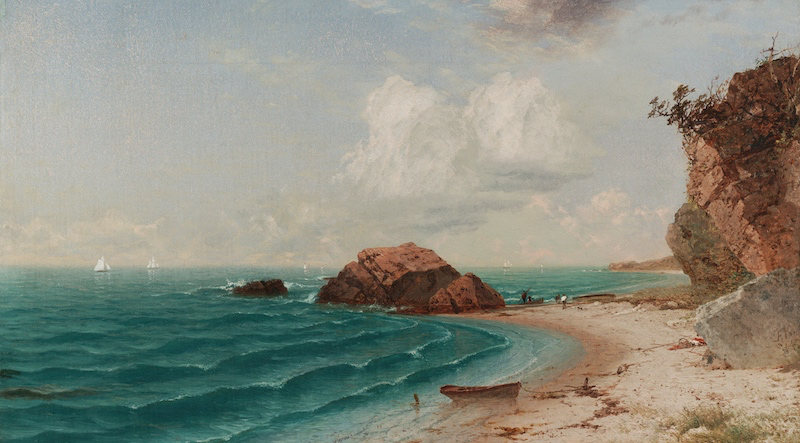
Having flown of late more often than I like, I can say with some certainty that entering the Museum of Modern Art in New York is just like arriving at an airport, only without the charm. The plan was to visit at opening time on a Monday morning, operating under the wildly misbegotten assumption that the building would be sleepily coming to life. In actuality, the atrium was so overfilled with visitors that labyrinthine cordons were necessary to pipe us through admissions and coat check lines, to say nothing of the elevator and escalator queues.
Right now MOMA is in the midst of Björkapalooza, so presumably a lot of people had come to view her many and diverse installations. It is one of a succession of high-profile exhibitions of contemporary artists the museum, presumably seeking a hip posture, has become fond of; Peter Schjeldahl wrote in The New Yorker, “Björk’s dignity endures. That of the museum disappears.”
I had a similarly ambivalent response to the current exhibition, One Way Ticket: Jacob Lawrence’s Migration Series. Thematically, the show has as much gravitas as anything the museum is likely to put up any time soon, but it’s consigned to a far corner of the third floor. Lawrence was an African-American prodigy, who in his early twenties conceived a series of paintings that would tell the story of the black exodus from the rural South to the urban North that occurred between world wars. His family was part of the migration’s first wave—Lawrence was born in Atlantic City in 1917, and landed in Harlem as a teenager.

In preparation for the Migration Series, Lawrence spent months reading at the New York Public Library’s 135th Street branch, the type of research that historical painters did in order to nail factual minutiae. Lawrence, though, wasn’t interested in authenticity of visual detail. “Soon my research,” he wrote in 1992, “gave me the images I needed to tell the story of the great migration.” The study of recent history fired his imagination and provided a foundation for his narrative: Blacks left the South en masse to find better jobs and living conditions in cities like New York, Chicago, and St. Louis (see Panel 1). The move wasn’t easy, and neither was the new life many encountered. Fearing a loss of cheap labor, white Southerners tried to impede the migration. Fearful of arrest or lynching if they stayed, many blacks overcame their hesitation to relocate.
Lawrence was twenty-two when he began the series. He assembled tables from boards and sawhorses in his studio, and his wife assisted in preparing the panels. Working from general preparatory sketches, he painted each panel one color at a time—if the order of the day was brown pigment, then the brown areas of each panel were painted all at once before moving to the next color, “so that they share the same palette.” The paintings’ stark abstract patterns are strongly reminiscent of woodblock prints.
Lawrence produced sixty small tempera paintings within a year, completing them in 1941. His use of a sequence of paintings for the purpose of historical narrative was novel; the Museum of Modern Art and the Phillips Collection in Washington, D.C., each wanting the panels, agreed to split them, with MOMA taking the even numbered paintings and the Phillips, the odds. “Lawrence’s work,” the museum notes, “is a landmark in the history of modern art and a key example of the way that history painting was radically reimagined in the modern era.”

If the significance of the Migration Series is readily acknowledged, the impact of its installation at MOMA is neutralized by well-meaning attempts to give the series historical context and to flesh out the exhibition with supplementary content. Adjacent to the single gallery housing the series are rooms featuring more of Lawrence’s work, as well as paintings by his contemporaries, a collection of photographs, graphic art, cartoons, books, and newspaper clippings chronicling the migration, followed by a darkened gallery in which videos are played; there is a continuous loop of Gospel, Spiritual, and Blues which can be heard throughout the exhibition. The Migration Series is treated less as art than a point of departure for a walk-through documentary. I came to view a singular performance by an important painter, and got a Ken Burns treatment instead.
I’m making a distinction between museums devoted to fine art and those devoted to national and ethnic history. The installation of the Migration Series underplays and subtly diminishes the art itself, subordinating the power and beauty of Lawrence’s images to the larger cultural story. My reservations may be written off to personal querulousness, and so be it. Since he painted the series as a history lesson, Lawrence probably would have been happy with the exhibition, which memorializes both the tragedy and the progress that were inherent in the migration. All the same, the paintings are more than journalism, and their value transcends both place and moment; Panel 22 is an all too timeless image, as recent events in the North remind us. In the end, color and design add up to a quiet woefulness. Lawrence never convincingly summons a spirit of optimism, and the effect of the series is that of subtle despair.
A postscript was provided the moment I left the museum via the Fifty-fourth Street exit. Across the street was a group of homeless men, two of whom sat on the sidewalk, while two stood yelling at one other. First I thought of the persistent sense of disenfranchisement of many urban blacks, a painful legacy of the great migration. Then I thought of the altercation from an artist’s perspective, imagining it as inspiration for a piece of social realism. And I realized that Lawrence, through first hand knowledge and a grasp of pictorial essentials, would have done a far better job with the subject than would most any other painter.



